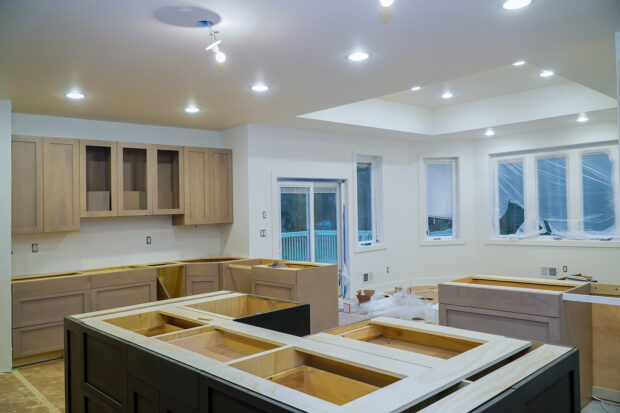The new year is often a time for reflection and resolution, creating an opportunity for independent agents to connect with customers on trends that could impact their risk levels. This proactive engagement provides a stronger customer experience, positioning agents as protection experts aware of current events and circumstances that may affect customers’ insurance needs. When agents have these strengthened relationships, it can lead to more account business, a deeper sense of customer loyalty and high-quality referrals. Oftentimes, agents can find opportunities to offer account solutions that can help prevent coverage gaps.
Executive Summary
The Hanover’s president of personal lines discusses trends including home remodels, labor and material shortages and the increased availability of IoT devices, all of which have impacts of personal lines insurance customers risk profiles. Here, he suggests that these trends can be talking points for agents as they seek to address customer needs with appropriate coverages, and recommends that carriers work to support agents by providing resources, educational materials and best practices for discussing all the emerging trends.Following are the top six trends we see impacting the personal lines industry today that naturally lead to these types of discussion.
- Property owners may face underinsurance risk due to home improvements.
With Americans spending more time at home, home remodeling projects have increased. For example, according to Verisk, the number of pool permits increased by nearly 57 percent year over year in the first five months of 2020 and 2021. With the surge of pool installations, agents can utilize these and other home updates to connect with customers to help ensure assets are properly protected.
This trend is set to continue. The Hanover’s recent 2021 Home Renovation Report found 69 percent of homeowners have plans to make improvements and renovations to their homes in the next year. Many consumers don’t realize that the coverage amount for home insurance should not be based on market value but on replacement cost. Updated homes and outdoor spaces combined with the increase in rebuilding costs may mean customers do not have enough Coverage A. It is also a good opportunity to discuss coverage such as service line and water backup, which can be valuable protection when doing home renovations.
- Shortages will cause higher claims costs and longer turnaround times.
Labor and material shortages will continue to impact supply chains and will hinder both consumers’ and businesses’ ability to get products and services. Most have heard of new car purchases being delayed, but how does this impact drivers when they need an auto repair due to an accident? It is taking longer for repair shops to get parts, forcing consumers to hold on to rental vehicles longer.
Depending on the policy, these extended rental needs may not be covered by a driver’s insurance policy. Consumers rely on agents who are knowledgeable about how potential shortages may impact the claims process and if they have enough coverage to accommodate any delays. Agents should talk to customers about additional living expenses and rental coverage.
- More severe, more frequent weather events lead to more damage.
Weather patterns are changing. Homeowners and insurance agents need to think beyond protection and preparation for catastrophic weather events like hurricanes and tornadoes. Well-informed agents that understand the impact of more severe weather events can guide customers on the proper protection to help ensure they have appropriate coverage, such as waiver of deductible, upgrading shingles for siding and roof restoration, replacement costs, or debris removal. Agents should help homeowners understand the importance of choosing the right shingles and sealing the roofdeck to prevent leaks. This is also a chance to share insights on the best preventative action homeowners can take based on their region’s common losses such as sump pumps and the best materials to use.
- Rising rates will lead to a rise in questions.
As with many costs and services today, insurance costs are on the rise. There are many external factors that are out of the control of both agents and insurance companies driving this trend. For example, there were 18 weather or climate-related disaster events in the U.S. in 2021 with losses exceeding $1 billion in damage.
That being said, the first call customers will make is to their agent. Having a ready-to-go response that points to more severe weather, higher material/labor costs and more fire/water damage will help agents retain business and compete with direct carriers. These events and consumer changes such as purchasing bigger, upscale homes are leading to higher replacement costs when damages arise. Carrier partners that are committed to advancing the independent agency channel can provide data and talking points to support these conversations.
- Customers are highly aware of liability issues.
Consumers are more aware of everyday risks and are looking for protection against these threats. Independent agents have an opportunity to discuss with consumers how they can stay protected from liability claims with affordable coverage that goes beyond the limits of their home or auto policy. As an added bonus, customers with these valuable coverages tend to be less price-sensitive. They are more concerned with protection and less likely to jump to a direct carrier for marginal savings.
- Influx of Internet of Things (IoT) devices and sensors to protect consumer assets.
As consumers look for convenient ways to protect their assets, they will continue to turn to technology. Whether it’s home water sensors that shut off the master water in the event of a leak or related issue, fire suppression technology that can automatically discharge a substance to reduce the damage caused by fires, electrical devices that monitor electrical patterns, or home security systems, this technology continues to be in demand.
In 2021, The Hanover saw requests for water backup coverage quotes more than double, indicating consumers are more aware of these risks and looking for agents to provide advanced protection solutions. With more Americans spending time away from their primary homes and an increase in the purchase of second homes, demand for these products is expected to rise. Installation of IoT devices can even lead to customer discounts, offering agents the opportunity to provide savings.
Carriers need to support agents having these conversations by providing resources, educational materials and best practices for discussing all emerging trends. Growth-minded and service-orientated independent agents recognize the importance of staying ahead of trends to help ensure their clients are properly covered and will develop strategic carrier partnerships with companies offering necessary resources. They strategically use these potential risk exposures to have timely conversations with their customers about adding valuable protection to help prevent potential coverage gaps and build long-term, prosperous account business.





















 Survey: Majority of CA/FL Homeowners See Rise in Insurance Costs, Coverage Changes
Survey: Majority of CA/FL Homeowners See Rise in Insurance Costs, Coverage Changes  Allstate’s Safe Driving App Helps Reduce Chance of Collision by 25%
Allstate’s Safe Driving App Helps Reduce Chance of Collision by 25%  USAA to Lay Off 220 Employees
USAA to Lay Off 220 Employees  Going, Going, Gone: ‘Disruption’ to Shrink Traditional Premiums for Auto
Going, Going, Gone: ‘Disruption’ to Shrink Traditional Premiums for Auto 




